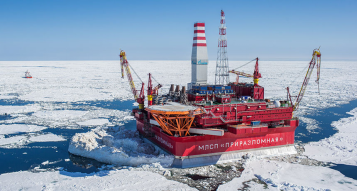
Climate change could turn the Arctic Ocean into a high-speed ice superhighway. Large pieces of sea ice in the Arctic are becoming thinner as old ice melts. The new ice that’s replacing it travels farther and faster than the older ice had. As the younger ice travels, it carries dirt, organisms(微生物) and pollution along for the ride, new research shows.
Researchers have been tracking the movements of Arctic ice for several years. They noticed that the area covered by ice making the trip from one side of the ocean to the other has grown larger and larger. That movement means that far-away reaches of the Arctic are becoming more connected, notes Robert Newton, from Columbia University.
“The speedy ice is a problem,” he explains. “The ice in the Arctic is surprisingly polluted,” he said. “When the ice travels from one part of the Arctic to the other, it carries all that material with it.”
Winds sweep air pollution north from lower latitudes. Much of that pollution can settle into the ocean and onto sea ice. Industries along Arctic coastlines, such as gold mining and oil drilling, also can pollute the region’s waters. As new ice forms in fall and winter, that pollution gets trapped inside the ice. When that ice then melts in spring and summer, it’ll bring the pollution it carried back into the ocean.
In the study, the researchers put snapshots(快照) of the Arctic together. The pictures came from satellites far above the surface. They used computer software that can recognize the edges of sea ice. This allowed them to follow the movements of ice from forming to melting. To help them do that, they also included tracking buoys(浮标) on the ice that had been equipped with GPS devices.
They found about 60% of Arctic ice travels less than 100 kilometers from its birthplace. The rest covers an area equal to tens of thousands of square kilometers. It can travel hundreds or even thousands of kilometers. And that ice is moving faster as well.
1.According to the passage, what makes the new ice travel faster?
A Its large size.
B Its small amount.
C Its small thickness.
D Its heavy weight.
解析:选C。C 细节理解题。根据第一段第二、三句“Large pieces of sea ice in the Arctic are becoming thinner as old ice melts. The new ice that’s replacing it travels farther and faster than the older ice had.” 可 知新形成的冰块厚度更小,所以动得更快,故选 C。
2.Robert Newton considers the speedy ice to be a problem because it _________.
A travels much faster than before
B is much easier to pollute than before
C results in more environmental disasters
D increases the risk of spreading pollution
解析:选D。D 推理判断题。根据第三段最后一句“When the ice travels from one part of the Arctic to the other, it carries all that material with it.”可知高速移动的冰 块之所以会成为麻烦是因其会传播污染,故选 D。
3.The fourth paragraph is intended to show how _________.
A the ice gets polluted
B the ocean is damaged
C the ice comes into being
D the ice affects the ocean
解析:选A。A 段落大意题。第四段前三句描述污染进入海洋, 根据第四句“As new ice forms in fall and winter, that pollution gets trapped inside the ice.”当新冰块 在秋季和冬季形成时,这些污染就会被困在冰 中。由此推断此本段主要在说明冰块是如何被污 染的。故选 A。
4.What does the underlined word “that” in Paragraph 5 refer to?
A Using computer software.
B Taking photos of the Arctic.
C Following the movements of ice.
D Collecting pictures through satellites.
解析:选C。C 词意指代题。根据第五段第四句“This allowed them to follow the movements of ice from formation to melting.”可知,这使他们能够跟踪冰 从形成到融化的运动,接下来这句就阐述他们如 何跟踪冰块运动。故选 C。